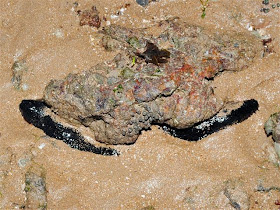We are back at the amazing shores of Tuas near Merawang Beacon! It has been more than two years since I have set foot on this colourful shore and we wonder how it is doing with the start of reclamation across at the Malaysia side.
Unfortunately, the tide was non-compliant and did not went down as low as we expected. Thus, we were mainly surveying the tiny crops of land that were exposed. Nevertheless, there were still much to see!
Some of us walked up towards the direction of the Tuas Second Link and had a closer look at tiny stretch of beautiful mangroves lining along the high shores.
And for the first time, I took this opportunity to walk all the way up to where Raffles Marina is near. The shore along this stretch is mainly rocky.
Some interesting finds include many of these Crown sea stars (Asterina coronata) which are usually found below rocks. As such, they are also known as rock stars!
There's also many shrimps of which these have pretty blue dots on its body.
There are also some parts dotted with lots of these Spoon seagrass (Halophila ovalis).
Along the rocky stretches, we came across many coral skeletons which reminds us of its past where this shore used to be a thriving coral reef. Many of these skeleton now form the basis of substrate as coral rubble in the marine habitat.
Flipping some of these old coral skeletons, one can find lots of living creatures beneath such as these Porcelain Crabs.
Talking about crabs, there were many of these Thunder crabs (Myomenippe hardwickii) lurking around. They are commonly found on northern rocky shores.
They were also some of the more uncommon Spotted-belly forceps crabs (Ozius guttatus) and they are about the same size as compared to the Thunder crabs. The Spotted-belly forceps crabs prefer rocky habitats and are usually found on the reefy southern shores.
The star surprise of the trip would be Ria's find of the Cryptic sea stars (Cryptasterina sp.)! These sea stars are not commonly found on our rocky shores and we are glad to find them on Tuas. I think it is our first sighting of these stars on Tuas!
Here is a photo comparison of the Crown sea star on the left and the Cryptic sea star on the right. The former has longer arms while the latter looks more like a blob with less prominent arms.
I went to search for more of these sea stars and uncovered about 5-6 more after a short while.
According to Dr David Lane's "A Guide to Sea Stars and Other Echinoderms of
Singapore", the cryptic stars live amongst rocks and stones on the upper
to mid-shore level. They have a mottled, but variable, colouration
which is actually for camouflage to be inconspicious to predators.
That's how their name come from. :)
Here's a closer shot of the aboral and underside of a six-armed version of the Cryptic star.
As the tide went slightly lower with time, more stuffs were uncovered such as the zoanthids and also many of the Haddon's carpet anemones (Stichodactyla haddoni).
I'm glad that the flowery soft corals (Family Nephtheidea) are still around and they are found at the deeper parts of the shore.
I also came across the Long black sea cucumber (Holothuria leucospilota) which are commonly found on our the rocky habitats of our Southern shores. In the north, they are not usually sighted except for the reefy parts of Pulau Sekudu.
Sticking out from the ground in mid-water levels are many of these Sea pencils, Flowery sea pens, Spiky sea pens (Pteroeides sp.) and Slender sea pens (Virgularia sp.).
This tiny Hairy crab (Pilumnus sp.) found among the mats of zoanthids is quite cool because it uses its hairs to trap sediments so as to camouflage itself (thought it's not well camouflaged at all in this photo haha!).
Chay Hoon found an tiny crab which we have not seen before!
From the underside, it looks somewhat like a Pebble Crab. We wonder what exactly this is.
As the tide was higher than usual, Ria with her walking stick was still very brave in wanting to cross over to the beacon side despite the waves, murky waters and her recovering foot condition. I salute her for that and took a few shots of her in action! :D
With our underwater camera, we still managed to capture some shots of the underwater garden of Tuas such as this Sea fan
(Order Gorgonacea).
It's good to know that the Starry leathery soft corals (Family Alcyoniidae) which are common on Tuas are still there!
All too soon, the sun went down from the horizon and it's time to say goodbye! While we are grateful for the good weather, we will have to come back another time on a lower tide to see more of what Tuas is home. This would be my last intertidal survey of 2014 and here's to more awesome adventures in 2015!

























No comments:
Post a Comment